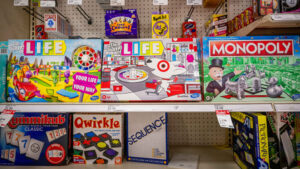Hasbro Navigates Tariff Turbulence: What Investors Need to Know
As the trade war intensifies, Hasbro, a major player in the toy industry, is grappling with significant challenges resulting from potential tariffs on imports from China. President Donald Trump’s proposed 145% levy could cost the beloved toy manufacturer an estimated $300 million. While Hasbro recently announced better-than-expected earnings, the long-term effects of trade policies remain a pressing concern for investors and analysts alike.
Understanding the Stakes
During a recent earnings call, Chief Financial Officer Gina Goetter articulated the uncertainty surrounding tariffs, noting that the company’s forecast anticipates scenarios ranging from a 50% tariff up to the alarming rate of 145%. "This translates to an estimated $100 million to $300 million gross impact across the enterprise in 2025," Goetter emphasized.
Hasbro CEO Chris Cocks reinforced that while no corporation is fully insulated from these economic shifts, Hasbro’s diverse portfolio—including robust gaming and licensing segments—positions the company well for the challenges ahead. This adaptability could be critical for investors looking for stability amidst volatility.
The Reality of Rising Costs
Cocks was candid about the realities of prolonged tariffs, indicating that they lead to structural costs and heightened unpredictability in the market. “Ultimately, tariffs translate into higher consumer prices,” he stated, highlighting a potential for consumer price hikes and job losses as the company navigates these turbulent waters.
While Hasbro’s gaming business benefits from domestic sourcing—many board games are manufactured in Massachusetts—its toy segment is more vulnerable due to a significant portion of production occurring in China. As Cocks mentioned, the company is actively seeking alternatives to realign its supply chain, although relocating production can come with its own set of challenges and higher costs.
Strategic Moves Ahead
Cocks shared insights into Hasbro’s forward-looking strategy, revealing that the company is considering moving some manufacturing from China to Turkey, which could help mitigate tariffs on products like Play-Doh. “This allows for innovative logistics—redirecting shipments from Europe to the U.S. while ensuring that factories in China can continue to supply the European market,” he explained.
However, transitioning manufacturing is not without difficulties; products that contain electronics or intricate designs can be particularly problematic to shift. That said, Cocks made it clear that China will continue to be an integral manufacturing hub for Hasbro due to the specialized skills developed over decades.
Cost-Saving Initiatives
In response to tariff pressures, Hasbro is ramping up its $1 billion cost-saving initiative, but Goetter and Cocks both conceded that price hikes are unavoidable. "We’re just trying to do it as selectively as possible," Cocks remarked, aiming to cushion the impact on families and fans.
As we venture deeper into a landscape marked by fluctuating trade policies, both Goetter and Cocks underscored the flexibility of Hasbro’s plans. They remain optimistic about potential shifts towards a "more predictable and favorable U.S. trade policy environment," emphasizing a dual strategy that involves both "defense and offense" in their operations.
Conclusion: What Investors Should Consider
Navigating these turbulent tariff waters will require agility and foresight. Investors keeping tabs on Hasbro should consider not only the immediate impacts of tariffs but also the strategic maneuvers the company is implementing to adapt to a changing economic landscape. With a focus on domestic manufacturing, innovative supply chain solutions, and a commitment to cost control, Hasbro continues to strive for resilience in uncertain times.
For more insights and analyses on the ever-evolving business landscape, stay connected with us at Extreme Investor Network, where we bring you in-depth financial perspectives and investment strategies tailored to help you navigate the future.

